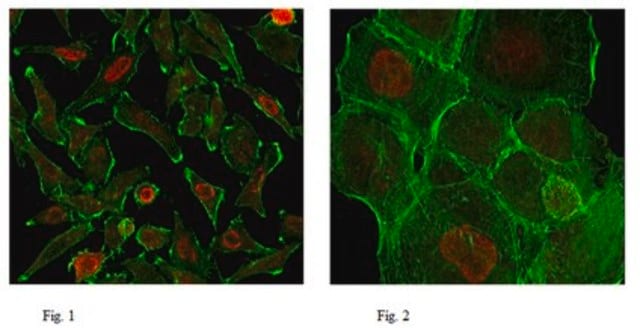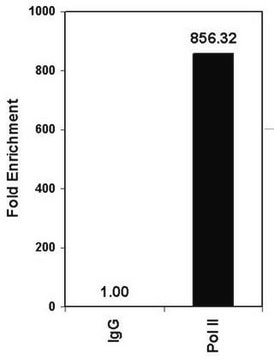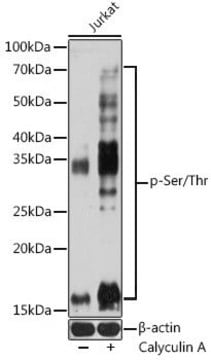SAB4200638
Monoclonal Anti−phospho−RNA polymerase II CTD (pSer5) antibody produced in rat
clone 1H4B6, purified from hybridoma cell culture
Synonym(e):
CCFDN, CTD (carboxy−terminal domain, RNA polymerase II, polypeptide A) phosphatase, CTD of POLR2A, FCP1, POLR2, POLRA, RNA polymerase II subunit A C-terminal domain phosphatase, RPB1, RPBh1, RPO2, RPOL2, RpIILS, TFIIF-associating CTD phosphatase 1, hRPB221, hsRPB1, phosphatase of, subunit 1, polymerase (RNA) II (DNA directed) polypeptide A 220kDa (POLR2A), serine phosphatase FCP1a, subunit 1CTDP1, transcription factor IIF-associating CTD phosphatase 1
About This Item
Empfohlene Produkte
Biologische Quelle
rat
Qualitätsniveau
Antikörperform
purified from hybridoma cell culture
Antikörper-Produkttyp
primary antibodies
Klon
1H4B6, monoclonal
Mol-Gew.
~250 kDa
Speziesreaktivität
human, rat, mouse, monkey, canine
Konzentration
~1 mg/mL
Methode(n)
immunoblotting: 0.5-1 μg/mL using whole extracts of HeLa cells.
immunofluorescence: 4-8 μg/mL using using HeLa cells.
Isotyp
IgG2b
UniProt-Hinterlegungsnummer
Versandbedingung
dry ice
Lagertemp.
−20°C
Posttranslationale Modifikation Target
phosphorylation (pSer5)
Angaben zum Gen
human ... POLR2A(5430)
mouse ... Polr2a(20020)
rat ... Polr2a(363633)
Allgemeine Beschreibung
Spezifität
Immunogen
Anwendung
Biochem./physiol. Wirkung
Physikalische Form
Lagerung und Haltbarkeit
Haftungsausschluss
Not finding the right product?
Try our Produkt-Auswahlhilfe.
Lagerklassenschlüssel
10 - Combustible liquids
WGK
WGK 1
Flammpunkt (°F)
Not applicable
Flammpunkt (°C)
Not applicable
Analysenzertifikate (COA)
Suchen Sie nach Analysenzertifikate (COA), indem Sie die Lot-/Chargennummer des Produkts eingeben. Lot- und Chargennummern sind auf dem Produktetikett hinter den Wörtern ‘Lot’ oder ‘Batch’ (Lot oder Charge) zu finden.
Besitzen Sie dieses Produkt bereits?
In der Dokumentenbibliothek finden Sie die Dokumentation zu den Produkten, die Sie kürzlich erworben haben.
Unser Team von Wissenschaftlern verfügt über Erfahrung in allen Forschungsbereichen einschließlich Life Science, Materialwissenschaften, chemischer Synthese, Chromatographie, Analytik und vielen mehr..
Setzen Sie sich mit dem technischen Dienst in Verbindung.








